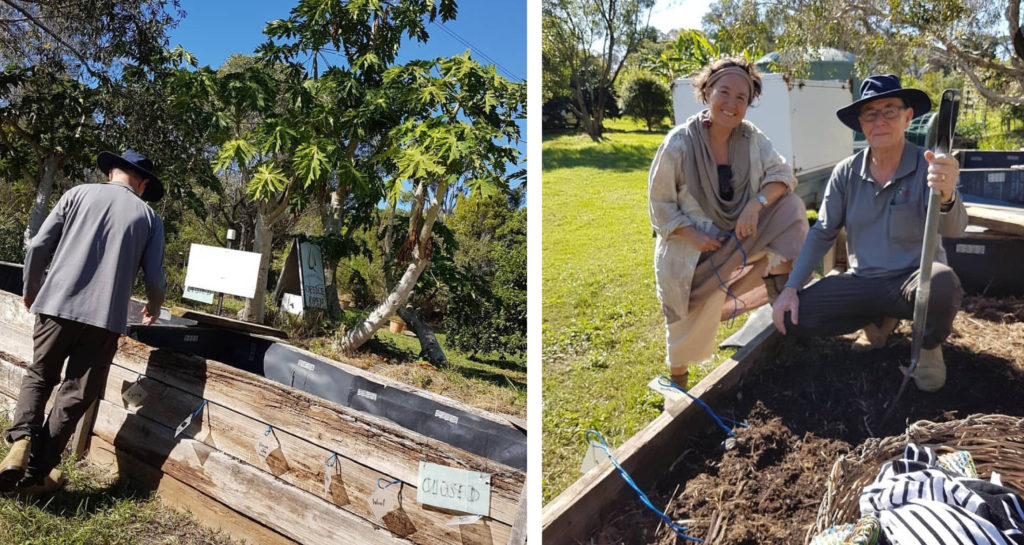There is simply no precedent for the volume of clothes in society today and we need to experiment with other ways of keeping material in circulation locally. When you’ve exhausted options for swapping/reselling clothes or donating them to charities, recycling in your backyard is a valid option. When something is biodegradable, it is capable of decomposing into raw materials and cycling back through the ecosystem without pollution. All natural-fibre clothing is in this category and therefore biodegradable, although the time taken will vary.
Composting your natural-fibre clothing works in exactly the same way as putting vegetable scraps and spoilt food into the compost. They decompose and becomes food for new plants. The composting process cycles four of life’s building blocks – carbon, oxygen, hydrogen and nitrogen – back into the soil so that it can support new growth. The clothing fibres need to be moistened to encourage and speed the decomposition process. The fibre becomes food for microbes, bacteria, fungi, moulds, worms, beetles, snails, mites, cockroaches and other critters, which are all part of the process.
I confirmed this in my backyard science experiment when I buried synthetic and natural fibre swatches in my garden during 2018. Almost all the natural fibres decayed while the synthetic remained untouched. Synthetics are derived from petroleum, do not absorb water, and are effectively plastic. In May 2019, we set up a compost experiment at Bulimba Creek Catchment Sustainability Centre at Carindale with which we will revisit at the end of August.
Plant fibres like cotton, linen, hemp and reconstituted fibres (bamboo, viscose) are mostly cellulose. They’re made up of carbon, oxygen and hydrogen compounds which are released into the soil as the fibres degrade. The soil can act as a carbon sink in the same way trees capture and store carbon.
Animal fibres like wool and silk are protein-based and break down into component parts of carbon, oxygen, nitrogen and hydrogen. Wool is particularly attractive to insects (as you may know if moths or silverfish have made a meal of your favourites over summer).
Hessian is often used as an organic liner for pots or to cover composting systems. Hessian is a close associate of hemp, linen and cotton, so it is not a great leap to compost all your natural-fibre clothing if you don’t have other ways of redeploying it.
There are some concerns about whether synthetic dyes and surface treatments used on clothes are safe in the environment or your compost. That is why some clothing may be specifically identified as compostable, because they have been coloured using vegetable dyes and no toxic treatments or synthetic inputs used. That way you can be assured that composting them will not bring nasties into your vegetable patch.
Clothing tags and threads routinely used in garments today are polyester, so ideally you need to cut away the seams and hems and put in the rubbish bin. You can then simply bury the remains, hosing it with water before covering with moist soil to encourage breakdown. However, cutting the garments into slightly smaller pieces may speed-up this breakdown.
Most sewing thread is polyester, so ideally cut out seams/hems as well as the interfacing (the white stiffening on collars and shirt fronts) and put them in the bin. Most buttons are plastic but worth saving. Buttons made from nuts or shells can be buried, but are worth reclaiming for someone to reuse. It takes a bit of effort to remove the zip from a garment, but at least cut around it if you can’t be bothered unpicking. These can also be donated in a bundle because there are committed sewists who are happy to reclaim such resources.
Cutting them into cleaning-rag size is a good option to use them on the way through to becoming compost or munched in worm farms. Other ideas are to use cloth in your garden as a weed suppression blanket by putting it on the soil and cover with a layer of mulch (sugarcane or bark) or use old cloth in the same way you use newspaper in a no-dig garden.
